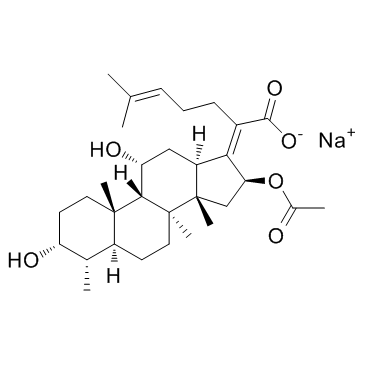Fusidic acid (sodium salt)

Fusidic acid (sodium salt) structure
|
Common Name | Fusidic acid (sodium salt) | ||
|---|---|---|---|---|
| CAS Number | 751-94-0 | Molecular Weight | 538.691 | |
| Density | N/A | Boiling Point | 635.6ºC at 760 mmHg | |
| Molecular Formula | C31H47NaO6 | Melting Point | N/A | |
| MSDS | Chinese USA | Flash Point | 197.6ºC | |
| Symbol |

GHS07 |
Signal Word | Warning | |
|
Engineering vascularized adipose tissue using the stromal-vascular fraction and fibrin hydrogels.
Tissue Eng. Part A 21(7-8) , 1343-53, (2015) The development of vascularized and functional adipose tissue substitutes is required to improve soft tissue augmentation. In this study, vascularized adipose tissue constructs were generated using uncultured cells from the stromal-vascular fraction (SVF) of ... |
|
|
Eruption in a patient with Crohn disease.
JAMA Dermatol. 149(1) , 97-102, (2013)
|
|
|
Crystal structures of EF-G-ribosome complexes trapped in intermediate states of translocation.
Science 340(6140) , 1236086, (2013) Translocation of messenger and transfer RNA (mRNA and tRNA) through the ribosome is a crucial step in protein synthesis, whose mechanism is not yet understood. The crystal structures of three Thermus ribosome-tRNA-mRNA-EF-G complexes trapped with β,γ-imidogua... |
|
|
Pseudomonas spp. and Serratia liquefaciens as Predominant Spoilers in Cold Raw Milk.
J. Food Sci. 80 , M1842-9, (2015) The storage of fresh raw milk at low temperature does not prevent proliferation of psychrotrophic bacteria that can produce heat-resistant proteolytic enzymes contributing to the reduced shelf life of dairy products. This study aimed to identify the dominant ... |
|
|
Susceptibility in vitro of canine methicillin-resistant and -susceptible staphylococcal isolates to fusidic acid, chlorhexidine and miconazole: opportunities for topical therapy of canine superficial pyoderma.
J. Antimicrob. Chemother. 70 , 2048-52, (2015) Increasing multidrug resistance amongst canine pathogenic staphylococci has renewed interest in topical antibacterial therapy for skin infections in the context of responsible veterinary prescribing. We therefore determined the activity in vitro of three clin... |
|
|
Culture condition-dependent metabolite profiling of Aspergillus fumigatus with antifungal activity.
Fungal Biol. 117(3) , 211-9, (2013) Three sections of Aspergillus (five species, 21 strains) were classified according to culture medium-dependent and time-dependent secondary metabolite profile-based chemotaxonomy. Secondary metabolites were analysed by liquid chromatography-electrospray ionis... |
|
|
Computational prediction and in vitro analysis of potential physiological ligands of the bile acid binding site in cytochrome c oxidase.
Biochemistry 52(40) , 6995-7006, (2013) A conserved bile acid site has been crystallographically defined in the membrane domain of mammalian and Rhodobacter sphaeroides cytochrome c oxidase (RsCcO). Diverse amphipathic ligands were shown previously to bind to this site and affect the electron trans... |
|
|
Current state of Clostridium difficile treatment options.
Clin. Infect. Dis. 55 Suppl 2 , S71-6, (2012) Recent reports of reduced response to standard therapies for Clostridium difficile infection (CDI) and the risk for recurrent CDI that is common with all currently available treatment agents have posed a significant challenge to clinicians. Current recommenda... |
|
|
Possible steps of complete disassembly of post-termination complex by yeast eEF3 deduced from inhibition by translocation inhibitors.
Nucleic Acids Res. 41(1) , 264-76, (2013) Ribosomes, after one round of translation, must be recycled so that the next round of translation can occur. Complete disassembly of post-termination ribosomal complex (PoTC) in yeast for the recycling consists of three reactions: release of tRNA, release of ... |
|
|
Antibiotics that affect the ribosome.
Rev. -. Off. Int. Epizoot. 31(1) , 57-64, (2012) The ribosome is a major bacterial target for antibiotics. Drugs inhibit ribosome function either by interfering in messenger RNA translation or by blocking the formation of peptide bonds at the peptidyl transferase centre. These effects are the consequence of... |